Meta’s AI-powered advertising once promised marketers a futuristic blend of automation and results in an ecosystem where brands could effortlessly reach the right audience at the right time. But in 2025, many businesses and marketers are voicing concerns: Meta’s AI targeting isn’t delivering as expected.
As a Meta ads agency deeply involved in ad performance diagnostics and campaign strategy, we’ve seen first-hand where things go wrong and how to course-correct. In this article, we’ll explore why Meta’s AI targeting is underperforming, what it means for advertisers, and what you can do to regain control and drive ROI.
The Promise of AI Targeting on Meta
Meta (formerly Facebook) introduced AI-based targeting to:
- Eliminate manual audience segmentation
- Enhance personalization
- Optimize performance through machine learning
In theory, the more data Meta collected, the better it would get at predicting user behavior. Advertisers could feed the algorithm, let it learn, and scale effortlessly. But in 2025, the cracks are more visible than ever.
What’s Going Wrong with Meta’s AI Targeting?
1. Over-Reliance on Broad Targeting
Meta’s AI pushes broad targeting as the default. While this works for large-budget campaigns, small to mid-sized advertisers often see inconsistent results and inflated CPAs.
2. Limited Visibility and Control
AI-driven ad setups often hide what’s really happening. Marketers can’t see which audiences are converting or where budget is being wasted.
3. Post-iOS 14 Fallout
Despite updates, data signal loss from iOS 14 and beyond still hampers Meta’s algorithmic learning. Retargeting pools and conversion tracking remain diluted.
4. Learning Phase Fatigue
Campaigns stay stuck in the “Learning Limited” phase. Without enough conversion data, the AI doesn’t optimize effectively, leading to wasted ad spend.
5. Ad Creative Mismatch
Meta’s AI sometimes pairs the wrong creative with the wrong user segment, especially with Dynamic Creative Optimization (DCO), hurting engagement.
6. Over-Optimization Bias
The algorithm narrows focus too quickly prioritizing early converters while ignoring potentially better long-term segments.
Real-World Impacts: What Advertisers Are Seeing
- Rising Cost Per Lead (CPL) and Cost Per Purchase (CPP)
- Falling engagement rates and ROAS
- Confusion over reporting metrics and attribution
- Frequent campaign resets with minimal performance gains
If you’ve been feeling like Meta campaigns no longer give you predictable returns, you’re not alone.
What You Can Do About It
1. Go Back to Manual Targeting Fundamentals
Even in an AI-first world, revisiting traditional targeting methods can yield better control:
- Build custom audiences with detailed interests
- Use demographic segmentation based on platform insights
- Layer geographic + behavioral filters
2. Leverage First-Party Data
Upload CRM lists, email subscribers, and website audiences. Match them with Meta to rebuild your pixel’s learning and strengthen performance.
3. Test Smaller Lookalike Audiences
Instead of 10% LLA, go with 1%-2% seed audiences. Higher similarity leads to better conversion rates.
4. Optimize Creatives for the Algorithm
Create multiple creative variants tailored to user segments. Analyze which formats (carousel, video, story) perform best.
5. Use Manual Placements
Avoid automatic placement if results are poor. Manually choose where your ads show Instagram Stories, Facebook Feed, Messenger, etc.
6. Reset the Learning Phase Intelligently
If stuck in Learning Limited:
- Consolidate ad sets to increase event volume
- Extend campaign durations
- Avoid overlapping audiences
7. Use Conversion API and Server-Side Tracking
Meta’s pixel isn’t enough anymore. Use Conversion API to send event data directly from your server and bypass browser restrictions.
Meta Ads Agency Tips: Pro Strategies We Recommend
As a leading Meta ads agency, here are some data-driven tips that consistently deliver:
a. Deep Funnel Attribution
Use tools like Triple Whale or Hyros to track across channels—not just Meta—giving you true ROI insights.
b. UGC-First Creatives
User-generated content often outperforms polished ads. It aligns better with organic feed behavior.
c. Weekly Creative Refresh
Avoid ad fatigue by refreshing headlines, hooks, and CTAs every 7–10 days.
d. Niche-Specific Retargeting
Use tailored messaging for abandoned carts, page viewers, or 3-second video watchers.
e. Ad Spend Allocation via Predictive Modeling
Use AI tools outside Meta to forecast winning audiences and direct budget accordingly.
Future of Meta Advertising: What’s Next?
Meta is working on improvements like AI transparency reports, better CAPI support, and real-time feedback loops but advertisers can’t afford to wait.
Trends to Watch:
- Rise of in-platform lead generation forms
- More granular reporting dashboards
- Integration of Threads and WhatsApp into ad inventory
- Continued expansion of Advantage+ campaign types
Conclusion: You Still Need Strategy in an AI World
AI can automate but it can’t replace strategic thinking. The brands winning in 2025 combine automation with human insight. They partner with a Meta ads agency that understands both algorithm behavior and creative psychology.
If Meta’s AI targeting is failing you, it’s time to take back control.
Need help fixing your Meta ad performance?
Partner with EON8 your trusted Meta ads agency to rebuild strategy, optimize creatives, and unlock growth.
Visit www.eon8.com to learn more about our Meta advertising services.
